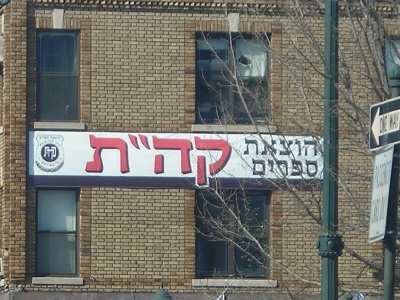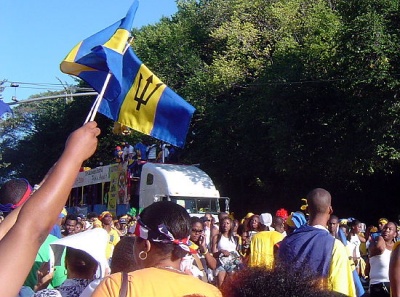Crown Heights: Here v. There
From Decoding New York
| Introduction |
| Brighton Beach |
| * Evolution |
| * What's Real |
| * Here v. There |
| * Economy |
| Crown Heights |
| * Evolution |
| * What's Real |
| * Here v. There |
| * Economy |
| Comparison |
| * Photo Gallery |
| * Sources
|
Emerging from the thundering subway tracks, I am pleasantly welcomed by serene Crown Heights. The neighborhood seemed at peace with itself nestled within the bustling electric atmosphere that symbolizes New York City. As I first encounter this new niche, I am quickly able to notice how distinct the Afro-Caribbean and Hasidic Jewish enclaves are from on another. Encompassing a wide spectrum of immigrants, Eastern Parkway contains a dense Caribbean/ West Indian community that resides along Utica Avenue while there is a concentration of Jewish culture along Albany Avenue. All told, there are about 200,000 residents of Crown Heights of which 40% are first generation immigrants. About three-quarters of the population is Afro-Carribean and African American, ten percent is Hispanic, and seven percent is Hasidic.
Many of the residents of Crown Heights have poured into this neighborhood in hope of starting a new life for their families by finding jobs and providing their children with opportunities that were not necessarily available to them int their mother country. After interviewing several people from the Afro-Caribbean and Hasidic communities, I noticed that there was a slight difference as to why many wanted to immigrate to Eastern Parkway. While both communities emigrated for a better life, the Hasidic Jews immigrated in large numbers to obtain a higher level of religious satisfaction through their studies. In comparison to Israel, where a majority of the Crown Heights residents have emigrated from, a Hasidic storeowner stated, “there is a different mentality here” in Crown Heights. Crown Heights enables people of the Hasidic community to feel connected with each other through their synagogues. Synagogues not only serve for daily prayer services but also they are used as an arena for religious academics and an assembly hall for religious gatherings in which the needs of the community are addressed. While many Hasidic Jews immigrated to Crown Heights for religious reasons, many Afro-Caribbeans immigrated to Eastern Parkway for economic reasons - through word of mouth that it is easier to find jobs in Crown Heights. While conducting interviews, we learned that many who have immigrated to Crown Heights do not plan on spending the rest of their lives there. They intend to make enough money so they can travel back home to the Carribean and live an easier life or to move to another state such as Georgia, as one man stated, to live a peaceful life away from the commotion and city life of Crown Heights.
Upon adjusting from their mother countries, which consisted largely of Israel and South Africa for the Jews,and Trinidad and Jamaica for the Afro-Caribbeans, each community has developed within an area in which their every needs can be met by local stores and services. Yet, the Hasidic population has been forced to assimilate to American culture in some ways. Although many of the interviewees stated that they were not Americanized, to some degrees it appears that many have become Americanized since store signs are in English and not in Hebrew unless grocery stores carry strictly glatt kosher meats and products in which Hebrew writing is then used. The ambivalent feelings that many admit to having about becoming somewhat Americanized can be seen through the yellow flags displayed on nearly every residential building. The flag displays a picture of a crown that symbolizes Crown Heights along with Hebrew lettering that represents the Jewish heritage. The flag greatly shows that the Hasidic Jews have assimilated while still holding strong to their roots.
Like the Hasidic population, the Afro-Caribbeans have greatly assimilated to American culture while strongly retaining their roots. Many interviewees openly stated that they have become Americanized. Even though there is a McDonald and a Subway fast food service, there are also Caribbean eateries such as the Golden Krust Caribbean Bar and Grill which serves Oxtail, Curry Chicken, Curry fried duck, and may other Caribbean delicacies. In addition, there are stores that exclusively sell products that are specifically for the Afro-Caribbean population such as hair products, vitamins, and much more. Even though many have stated that they are somewhat Americanized, a woman from Grenada stated that she takes her daughter back to Grenada or “home” ever so often in order for her daughter not to “forget where she came from” so that she can feel “connected to her real home.” Just by calling Grenada her “real home,” shows that this woman deems Crown Heights as a place for financial advances for herself and endless opportunities for her daughter. Furthermore, despite all the advantages of living in Crown Heights, this woman tightly holds to her culture, which has molded her into the person that she is today.
Afro-Caribbeans show that even though they have become Americanized, they still hold on to their culture with the annual Labor Day celebration of the West Indian Carnival and Parade. Some 1,000,000 people come to watch 2,000 to 3,000 band members, including the famous steel bands, play music while participants, dressed in extravagant sequined costumes, march or ride on elaborate floats. The parade has been a tradition since 1969 with participation from all the ethnic groups of the Carribean, including Haiti, Jamaica, Trinidad & Tobago, Barbados and Grenada. The parade is a way for the Afro-Caribbeans to assert their roots and tradition in the present. Seeing how diverse the parade is, Charles, a Caribbean shopowner, observes, “Crown Heights is diverse but there is a multitude of people here that interact with each other and learn from each other which would not necessarily be the case back at home.”

